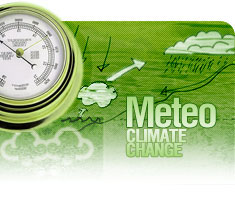Warming temperatures are pushing land and sea creatures closer to the north and south poles and to cooler altitudes at rates faster than first predicted, scientists say.
"That's a species that eats kelp and seagrass and other plant material and algal habitats and basically turns regions into rocky urchin barrens," she said.
"[It] just denudes the area of all sorts of plant material and makes it not a very nice habitat for abalone, rock lobster and other fish species."
Ecology Professor Hugh Possingham from the University of Queensland said sometimes humans needed to intervene and move species in order to save the plants and animals from extinction.
"We've fragmented a lot of habitats and so many of these species might've moved through moving towards the poles as they do with the warming temperatures," he said.
"And they could've moved towards the poles, but we've fragmented their habitats so much with cities and roads and agriculture that they need help moving a bit faster."
'Indicator species', like butterflies, important
Professor Parmesan said the conference was not just about plants and animals having to move, humans also needed to adapt to climate change.
"A lot of people want to know why should they care about a butterfly moving from the US to Canada, and my point is that these are indicator species," she said.
"What we're seeing is that 1 degree centigrade warming is having a massive effect on wild plants and animals.
"Humans do rely on wild plants and animals whether we like to accept it or not, and humans also have sort of a restrictive climate space that they live in."
Professor Stephen Williams from James Cook University said Indigenous Australians had reported changes in local species.
"Some Aboriginal people have come to me and talked about changes in the behaviour of animals that they're familiar with, the breeding seasons of the animals, the flowing seasons," he said.
"Things like possums, some of the iconic species of the rainforest, have been getting pushed up the mountain, they're going up to the cooler areas.
"The predictions in the future are the really scary bit, though. Fully half of the species that the world heritage area was put in place to protect, are predicted to go extinct in this century.
"There's been a lot of observations around the world of tropical diseases, for instance, moving into areas that they've never been in before. And this is diseases both for people and for animals."
Professor Williams believes it is possible to arrest the decline in species.
"If we just follow a reasonable emission control strategy, one that is actually possible, it will reduce it from 60 species going extinct to only two or three, so massive differences can be achieved," he said.
Finland's last proper winter in 1986
"That's a species that eats kelp and seagrass and other plant material and algal habitats and basically turns regions into rocky urchin barrens," she said.
"[It] just denudes the area of all sorts of plant material and makes it not a very nice habitat for abalone, rock lobster and other fish species."
Ecology Professor Hugh Possingham from the University of Queensland said sometimes humans needed to intervene and move species in order to save the plants and animals from extinction.
"We've fragmented a lot of habitats and so many of these species might've moved through moving towards the poles as they do with the warming temperatures," he said.
"And they could've moved towards the poles, but we've fragmented their habitats so much with cities and roads and agriculture that they need help moving a bit faster."
'Indicator species', like butterflies, important
Professor Parmesan said the conference was not just about plants and animals having to move, humans also needed to adapt to climate change.
"A lot of people want to know why should they care about a butterfly moving from the US to Canada, and my point is that these are indicator species," she said.
"What we're seeing is that 1 degree centigrade warming is having a massive effect on wild plants and animals.
YouTube: Global Climate Change Network discusses its role
"Humans do rely on wild plants and animals whether we like to accept it or not, and humans also have sort of a restrictive climate space that they live in."
Professor Stephen Williams from James Cook University said Indigenous Australians had reported changes in local species.
"Some Aboriginal people have come to me and talked about changes in the behaviour of animals that they're familiar with, the breeding seasons of the animals, the flowing seasons," he said.
"Things like possums, some of the iconic species of the rainforest, have been getting pushed up the mountain, they're going up to the cooler areas.
"The predictions in the future are the really scary bit, though. Fully half of the species that the world heritage area was put in place to protect, are predicted to go extinct in this century.
"There's been a lot of observations around the world of tropical diseases, for instance, moving into areas that they've never been in before. And this is diseases both for people and for animals."
Professor Williams believes it is possible to arrest the decline in species.
"If we just follow a reasonable emission control strategy, one that is actually possible, it will reduce it from 60 species going extinct to only two or three, so massive differences can be achieved," he said.
Finland's last proper winter in 1986
"That's a species that eats kelp and seagrass and other plant material and algal habitats and basically turns regions into rocky urchin barrens," she said.
"[It] just denudes the area of all sorts of plant material and makes it not a very nice habitat for abalone, rock lobster and other fish species."
Ecology Professor Hugh Possingham from the University of Queensland said sometimes humans needed to intervene and move species in order to save the plants and animals from extinction.
"We've fragmented a lot of habitats and so many of these species might've moved through moving towards the poles as they do with the warming temperatures," he said.
"And they could've moved towards the poles, but we've fragmented their habitats so much with cities and roads and agriculture that they need help moving a bit faster."
'Indicator species', like butterflies, important
Professor Parmesan said the conference was not just about plants and animals having to move, humans also needed to adapt to climate change.
"A lot of people want to know why should they care about a butterfly moving from the US to Canada, and my point is that these are indicator species," she said.
"What we're seeing is that 1 degree centigrade warming is having a massive effect on wild plants and animals.
YouTube: Global Climate Change Network discusses its role
"Humans do rely on wild plants and animals whether we like to accept it or not, and humans also have sort of a restrictive climate space that they live in."
Professor Stephen Williams from James Cook University said Indigenous Australians had reported changes in local species.
"Some Aboriginal people have come to me and talked about changes in the behaviour of animals that they're familiar with, the breeding seasons of the animals, the flowing seasons," he said.
"Things like possums, some of the iconic species of the rainforest, have been getting pushed up the mountain, they're going up to the cooler areas.
"The predictions in the future are the really scary bit, though. Fully half of the species that the world heritage area was put in place to protect, are predicted to go extinct in this century.
"There's been a lot of observations around the world of tropical diseases, for instance, moving into areas that they've never been in before. And this is diseases both for people and for animals."
Professor Williams believes it is possible to arrest the decline in species.
"If we just follow a reasonable emission control strategy, one that is actually possible, it will reduce it from 60 species going extinct to only two or three, so massive differences can be achieved," he said.
Finland's last proper winter in 1986
"That's a species that eats kelp and seagrass and other plant material and algal habitats and basically turns regions into rocky urchin barrens," she said.
"[It] just denudes the area of all sorts of plant material and makes it not a very nice habitat for abalone, rock lobster and other fish species."
Ecology Professor Hugh Possingham from the University of Queensland said sometimes humans needed to intervene and move species in order to save the plants and animals from extinction.
"We've fragmented a lot of habitats and so many of these species might've moved through moving towards the poles as they do with the warming temperatures," he said.
"And they could've moved towards the poles, but we've fragmented their habitats so much with cities and roads and agriculture that they need help moving a bit faster."
'Indicator species', like butterflies, important
Professor Parmesan said the conference was not just about plants and animals having to move, humans also needed to adapt to climate change.
"A lot of people want to know why should they care about a butterfly moving from the US to Canada, and my point is that these are indicator species," she said.
"What we're seeing is that 1 degree centigrade warming is having a massive effect on wild plants and animals.
Humans do rely on wild plants and animals whether we like to accept it or not, and humans also have sort of a restrictive climate space that they live in."
Professor Stephen Williams from James Cook University said Indigenous Australians had reported changes in local species.
"Some Aboriginal people have come to me and talked about changes in the behaviour of animals that they're familiar with, the breeding seasons of the animals, the flowing seasons," he said.
"Things like possums, some of the iconic species of the rainforest, have been getting pushed up the mountain, they're going up to the cooler areas.
"The predictions in the future are the really scary bit, though. Fully half of the species that the world heritage area was put in place to protect, are predicted to go extinct in this century.
"There's been a lot of observations around the world of tropical diseases, for instance, moving into areas that they've never been in before. And this is diseases both for people and for animals."
Professor Williams believes it is possible to arrest the decline in species.
"If we just follow a reasonable emission control strategy, one that is actually possible, it will reduce it from 60 species going extinct to only two or three, so massive differences can be achieved," he said.
Finland's last proper winter in 1986
Finnish speaker Dr Tero Mustonen, a fisherman, is sharing his expertise about how indigenous communities in the Arctic are adapting to climate change.
"We have lost one third of our ice season and all of this has impacts for the animals, for the livelihoods, for the culture and everything, so the winters have really changed in my lifetime," he said.
When we don't have the ice everybody's anxious, everybody's afraid. We also have a lot of social ills...in these remote communities like alcoholism and abuse.
Tero Mustonen, Finnish fisherman
"Fish are under more stress because it's warm. It's warmer in the autumn, the lakes don't freeze at appropriate times and the water stays very warm.
"[The year] 1986 was the last of the proper winters where we used to have proper cold temperatures."
Climate change is also causing social problems, Dr Mustonen said.
"When we don't have the ice everybody's anxious, everybody's afraid. We also have a lot of social ills in the Arctic in these remote communities like alcoholism and abuse," he said.
Mr Mustonen said locals had adapted to climate change by restoring a lake.
"We are trying to do this in the villages so that nature itself has the capacity to produce safe havens, if you will, and diversity," he said.
"And when you have diversity and restored land, waters and air, forests, you also have healthy people.
"You don't have to be having a PhD to realise that, and that's our best defence when we are restoring, reclaiming and maintaining who we are as a people."



 Română
Română English
English


